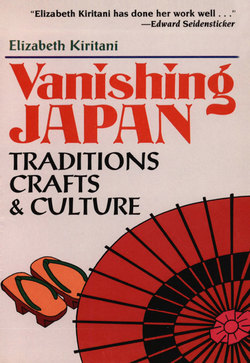Читать книгу Vanishing Japan - Elizabeth Kiritani - Страница 16
На сайте Литреса книга снята с продажи.
ОглавлениеNatural Tatami
"Nyobo to tatami wa atarashii ho ga yoi" (wives and tatami are both best when new) is a comment on the delightful fresh smell of new tatami mats. This old saying may be obsolete on both counts. The modern bride's housekeeping and cooking skills have been reduced by the demands of the educational system. And with "modernization" and "improvements," the tatami of today may not be what it seems. In any case, whenever one conjures up a picture of Japan, tatami, along with kimono and cherry blossoms, invariably comes to mind. As section after section of Japan's cities are being rebuilt, what is happening to the ubiquitous tatami?
Tatami itself isn't vanishing, but perhaps the trade of making it is. Most new houses have only one tatami room, either the living room or guest room. But although today's homes have fewer tatami, the construction boom is stimulating a lot of business, making it difficult to determine the actual decline in use.
Tatami is composed of three separate parts—toko, omote, and heri—made by different artisans and assembled by "tatami makers" in their small shops. About 23,000 of these tatamiya remain, although the number is decreasing every year.
The toko, or base, is five centimeters thick and is, traditionally, made of pressed straw woven with linen threads (the woof). Machine woven since the Taisho Era (1912-26), toko lasts forty years or more. The longer the wara (straw) used, the higher quality the mat. Because rice-harvesting machines chop wara into short pieces that are unsuitable for tatami, Japan has been importing wara from Taiwan for over ten years now.
The omote, the thin visible surface, is made of igusa (rush), the majority of which is woven in Okayama, Hiroshima, Fukuoka, and Kumamoto. With traditional wara toko, the omote is used for three years, reversed for another two years, and then replaced.
The third part, the heri, is the border that once was silk, linen, or cotton, but is now mainly synthetic fabric. Unlike previously, today heri patterns and colors are freely chosen by the user. Rooms with a tokonoma (wall niche for displaying art or flowers), however, still frequently have a mon (crest) pattern on the heri.
Over the ages, tatami size was gradually standardized so completely that the number of mats a room can contain became a way of measuring its size. But the standards are relative: the size of tatami varies according to region. A twelve-mat room in Tokyo is considerably smaller than one in Kyoto.
During the Heian Period (794-1195), only court people used tatami. The color of the heri indicated the owner's rank. The higher the rank, the more mats they could pile up to elevate their sitting positions. It wasn't until the late 1600s that ordinary households had tatami. In terms of expense, today a tatami room costs roughly three times as much as a regular room to build.
Tatami has a practical side that, despite its higher price, ensures its continued use in Tokyo and similarly crowded cities. A tatami room can sleep many, whereas a room with beds can sleep only one or two. Tatami rooms can also be used for multiple purposes: in my home, our four-and-a-half-mat room serves as our dining room, living room, kitchen, guest room, and bedroom. How's that for economy?
Tatami is increasingly being made of plastic. According to Chojiro Shimizu, head of the National Federation of Tatami Unions, the majority of new tatami toko consists of a thin oil-based perforated plastic with thick Styrofoam beneath it. This innovation is promoted by construction companies due to lower cost (not necessarily for the customer), light weight (a new-type mat weighs less than five kilograms; real tatami can weigh up to thirty kilograms), and easy maintenance (no bugs; no need for airing).
The "breathing quality" of natural tatami, which absorbs as much as one cup of moisture per mat, is lost. Natural tatami also reduces noise, is good insulation, biodegradable, and not so hazardous during a fire. And for anyone sitting seiza style (on folded legs) for any length of time, there is a real difference in comfort.
What about the bugs or fleas that are occasionally attributed to tatami? According to Mr. Shimizu, new toko must be aged a full year before use to ensure bug-free mats. Once installed, traditional mats should be stacked outside, aired, and beaten twice a year. Mr. Shimizu added that the city of Tokyo encourages the use of plastic mats because the semiannual airing process produces four times the amount of trash on airing days. This strains the city clean-up services. I myself prefer the inconvenience of airing and pounding rather than having to put up with pain in my legs caused by the newer species. My husband Itsuo, who has to lug the thirty kilogram mats outdoors, may have a different opinion.
